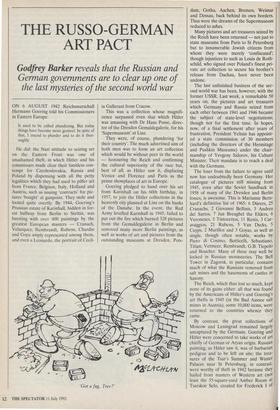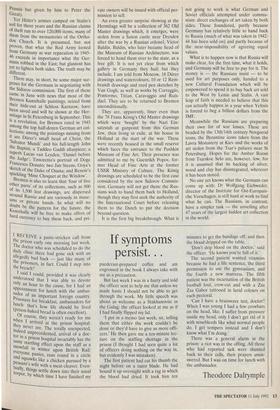THE RUSSO-GERMAN ART PACT
Godfrey Barker reveals that the Russian and German governments are to clear up one of the last mysteries of the second world war
ON 6 AUGUST 1942 Reichsmarschall Hermann Goering told his Commissioners in Eastern Europe:
It used to be called plundering. But today things have become more genteel. In spite of that, I intend to plunder and to do it thor- oughly.
He did: the Nazi attitude to seizing art on the Eastern Front was one of unashamed theft, in which Hitler and his commissars made clear their limitless con- tempt for Czechoslovakia, Russia and Poland by dispensing with all the petty legalities which they had used to pilfer art from France, Belgium, Italy, Holland and Austria, such as issuing 'contracts' for pic- tures 'bought' at gunpoint. They stole and looted quite overtly. By 1944, Goering's Prussian estate of Karinhall, hidden in for- est halfway from Berlin to Stettin, was bursting with over 400 paintings by the greatest European masters — Cranach, Velazquez, Rembrandt, Rubens, Chardin and Goya amply represented among them, and even a Leonardo, the portrait of Cecil- ia Gallerani from Cracow.
This was a collection whose magnifi- cence surpassed even that which Hitler was amassing with Dr Hans Posse, direc- tor of the Dresden Gemaldegalerie, for his `Supermuseum' at Linz.
They were, of course, plundering 'for their country'. The much advertised aim of both men was to form an art collection which would be without peer in the world — honouring the Reich and confirming the cultural superiority of the race but, best of all, as Hitler saw it, displacing Venice and Florence and Paris as the prime showplaces of art in Europe.
Goering pledged to hand over his art from Karinhall on his 60th birthday, in 1957, to join the Hitler collections in the heavenly city planned at Linz on the banks of the Danube. In the event, the Red Army levelled Karinhall in 1945, failed to put out the fire which burned 328 pictures from the Gemaldegalerie in Berlin and removed many more Berlin paintings, as well as works of art and pictures from the outstanding museums at Dresden, Pots-
'Got a fag, Trey?' dam, Gotha, Aachen, Bremen, Weimar and Dessau, back behind its own borders. Thus were the dreams of the Supermuseum reduced to ashes.
Many pictures and art treasures seized by the Reich have been returned — not just to state museums from Paris to St Petersburg but to innumerable Jewish citizens from whom they were merely 'confiscated'; though injustices to such as Louis de Roth- schild, who signed over Poland's finest pri- vate art collection to secure his brother's release from Dachau, have never been undone.
The last unfinished business of the sec- ond world war has been, however, with the former USSR. Last week, a remarkable 50 years on, the pictures and art treasures which Germany and Russia seized from each other between 1941 and 1946 became the subject of state-level negotiations; though not for the first time. In hopes, now, of a final settlement after years of frustration, President Yeltsin has appoint- ed a state commission of 30 members (including the directors of the Hermitage and Pushkin Museums) under the chair- manship of Yevgeny Sidorov, his Culture Minister. Their mandate is to reach a deal with the Germans.
The loser from the failure to agree until now has undoubtedly been Germany. Her catalogue of pictures still missing from 1945, even after the Soviet handback in 1958 of many of the Dresden and Berlin losses, is awesome. This is Marianne Bern- hard's definitive list of 1965: 6 Diirers, 25 Cranachs, 2 Giovanni Bellinis, 3 Andrea del Sartos, 7 Jan Breughel the Elders, 6 Veroneses, 5 Tintorettos, 11 Renis, 3 Car- avaggios, 21 Rubens, 5 Van Dycks, 5 Cuyps, 2 Murillos and 3 Goyas, as well as single, though often notable, works by Piero di Cosimo, Botticelli, Sebastiano, Titian, Vermeer, Rembrandt, G.B. Tiepolo and Boucher. Many of these may well be locked in Russian monasteries. The Bell Tower in Zagorsk, in particular, contains much of what the Russians removed from salt mines and the basements of castles in Saxony.
The Reich, which thus lost so much, kept none of its gains either: all that was found by the Americans of Hitler's and Goering's art thefts in 1945 (in the Bad Aussee salt mines in Austria), some 10,000 items, were returned to the countries whence they came.
By contrast, the great collections of Moscow and Leningrad remained largely uncaptured by the Germans. Goering and Hitler were concerned to take works of art chiefly of German or Aryan origin. Russian painting, as Hitler saw it, was of barbarian pedigree and to be left on site; the trea- sures of the Tsar's Summer and Winter Palaces near St Petersburg, in contrast, were worthy of theft in 1942 because they hailed from masters of Western art (not least the 55-square-yard Amber Room at Tsarskoe Selo, created for Frederick I of
Prussia but given by him to Peter the Great).
Yet Hitler's armies camped on Stalin's soil for three years and the Russian claims of theft run to over 120,000 items, many of them from the monasteries of the Ortho- dox Church. It is presumed, but not proven, that what the Red Army looted from Germany as war reparation in 1945- 46 exceeds in importance what the Ger- mans robbed in the East; but glasnost has yet to lighten both sides. The truth may be different.
There may, in short, be some major sur- prises for the Germans in negotiating with the Sidorov commission. The first of these came in June with news that most of the Bremen Kunsthalle paintings, seized from their hide-out at Schloss Karnzow, have been saved and will be shown at the Her- mitage in St Petersburg in September. This is a revelation, for Bremen rated in 1945 among the top half-dozen German art col- lections; among the paintings missing from It are Diirer's small head of Christ, the Salvator Mundi' and his full-length John the Baptist; a Taddeo Gaddi altarpiece; a superb Lucas van Leyden, `Daniel before the Judge'; Tintoretto's portrait of Doge Francesco Donato; two Jan Steens, Goya's sketch of the Duke of Osuna; and Renoir 's sparkling 'Mme Choquet at the Window'. Bremen is also to learn that 'four of five other parts' of its collections, such as 800 of its 1,500 lost drawings, are dispersed around Russia and are variously in muse- ums or private hands. In what will no doubt be the pattern for the future, the Kunsthalle will be free to make offers of hard currency to buy these back, and pri-
vate owners will be issued with official per- mission to sell.
An even greater surprise showing at the Hermitage will be a collection of 362 Old Master drawings which, it emerges, were stolen from a Saxon castle near Dresden after the war by a Russian colonel, Victor Baldin. Baldin, who later became head of the Museum of Russian Architecture, was forced to hand them over to the state, as a free gift. It is not yet clear from which gallery in Germany they hail; but they include, I am told from Moscow, 18 Diirer drawings and watercolours, 10 or 12 Rem- brandt drawings and reed pen sketches by Van Gogh, as well as works by Correggio, Pontormo, Titian, Caravaggio and Ruis- dael. They are to be returned to Bremen unconditionally.
They are, apparently, finer even than the 78 Frans KOnig's Old Master drawings which were `bought' by the Nazi Ein- satzstab at gunpoint from this German Jew, then living in exile, at his house in Holland at the start of the war. These were recently housed in the small reserve which faces the entrance to the Pushkin Museum of Fine Art. Their presence was admitted to me by Guenrikh Popov, for- mer Head of Fine Arts at the former USSR Ministry of Culture. The KOnig drawings are scheduled to be the first case considered by the new Sidorov Commis- sion. Germany will not get them: the Rus- sians wish to hand them back to Holland, though they may first seek the authority of the International Court before releasing them to the Dutch to put the decision beyond question.
It is the first big breakthrough. What is not going to work is what German and Soviet officials attempted under commu- nism: direct exchanges of art taken by both sides. These foundered, partly because Germany has relatively little to hand back to Russia (much of what was taken in 1942- 44 has been sold on) and partly because of the near-impossibility of agreeing equal values.
What is to happen now is that Russia will make clear, for the first time, what it holds, and Germany will be free to pay for it. The money is — the Russians insist — to be used for art purposes only, handed to a new Cultural Foundation which will be empowered to spend it to buy back art sold to the West by Lenin and Stalin. A vast leap of faith is needed to believe that this can actually happen in a year when Yeltsin is forced to beg a billion dollars from the IMF.
Meanwhile the Russians are preparing their own list of war losses. These are headed by the 13th/14th century Novgorod icons, the Byzantine icons taken from the Lavra Monastery at Kiev and the works of art stolen from the Tsar's palaces near St Petersburg. Hopes for the Amber Room from Tsarskoe Selo are, however, low, for it is assumed that its backing of silver, wood and clay has disintegrated, wherever it has been stored.
No one yet knows what the Germans can come up with: Dr Wolfgang Eichweder, director of the Institute for Ost-Europais- che Vorschagen, is still hard at work to find what he can. The Russians, in contrast, have a simpler task — the unveiling after 47 years of the largest hidden art collection in the world.



















































 Previous page
Previous page